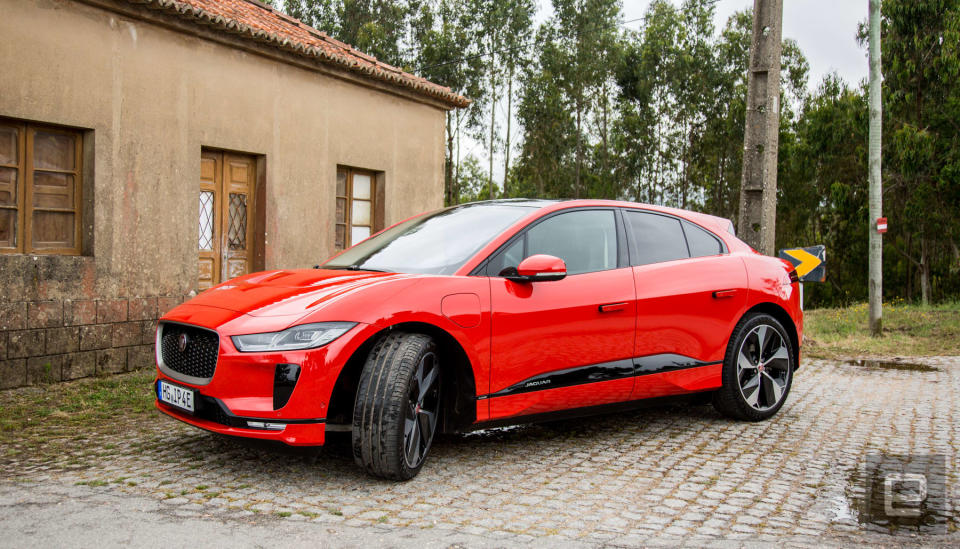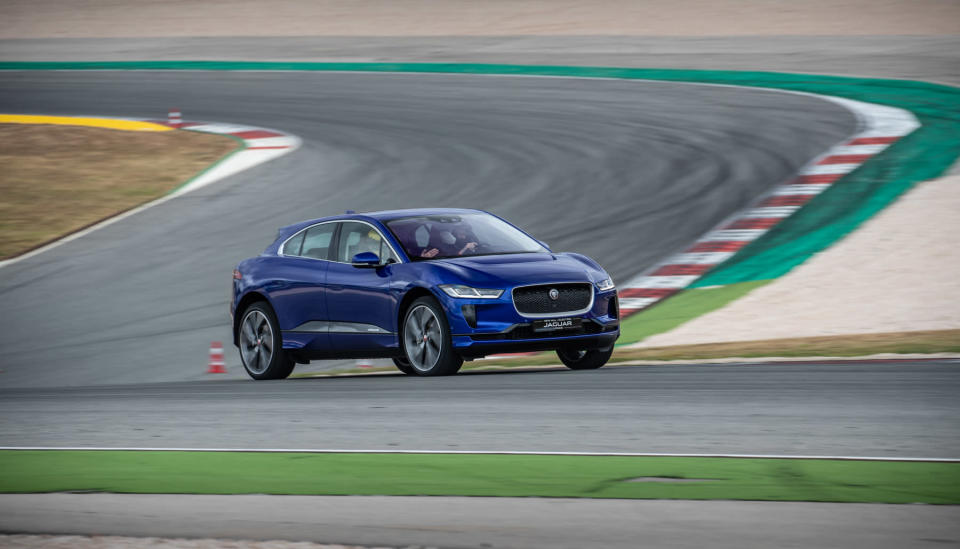Jaguar I-Pace review: A luxury EV that can tackle anything
Even the Tesla Model X.
A gentleman in a field peeks into the car and asks me to raise the height of the red First Edition I-Pace I'm driving then gestures towards a few feet of water ahead of me. "Don't go too fast, there are sharp rocks down there," he says. I've driven the car for a few hours already and am already a fan of its capabilities on paved roads and the luxury interior. Now I'm about to drive the crossover on a "surprise" off-road course and sure, why not. Let's do this. The Jaguar I-Pace is an electric vehicle four years in the making. The vehicle is the result of CEO Dr. Ralf Speth's unilateral decision that the company build a pure electric luxury SUV. Ever since its conception, design, engineering and finally production, the Tesla Model X has owned the segment. Not just because it's the only real luxury SUV that runs totally on batteries, it's also a very good vehicle. But after two days behind the wheel of the I-Pace, not only has the segment gotten a little bit more crowded, it might just have a new leader. Back on the off-road course in southern Portugal, the I-Pace made short work of the water obstacle. A steep entrance into the silty liquid, a quick left turn and we drove out of it after about 30 feet. All the while, inside the crossover, the vehicle was pure Jaguar with all the luxury, refinement and comfort you'd expect. This portion of the two-day drive was clearly the result of the automaker borrowing off-road capabilities from its sister company, Land Rover, and sticking it in the cat. With that in mind, it wasn't surprising when the I-Pace's all-wheel-drive system was able to conquer a rutted, steep path up a mountain. Even when it seemed to falter (ever so slightly), the traction system corrected itself and we forged ahead. About halfway up the "road" another gentleman has us put the car in Adaptive Dynamics, Adaptive Surface Response (AdASR) mode. It's a bit like cruise control but for tackling challenging terrain. I set it to 12kmh (about 7.5 mph) and all I had to do was steer. Of course, most I-Pace owners won't be taking it through creeks. (It can wade into water up to 19.7-inches deep.) Or up steep dirt roads riddled with gravel, potholes and deep ruts with cruise control (AdASR mode is available on the top-end First Edition trim, which starts at $85,900). Instead, they'll drive it around town, on the highway, on twisty roads and occasionally on dirt and gravel roads where the S model (starting at $69,500) handled all those environments without an issue. It even took on a race track where it was pushed to the limit and surprised me with its handling and acceleration when pushed to the limit. Especially for a large car with a heavy battery pack sitting at the bottom of the frame. That 90kWh battery pack is where all the power that gives the crossover a 0-to-60 time of 4.5 seconds comes from. In conjunction with two electric motors (one in the front and one in the back) the vehicle pushes out 394 horsepower and 512 pounds of torque. The result is a large car that can leap off the line at stop lights and easily get you up to speed from the freeway onramp. When you do get onto that freeway, the adaptive cruise control and steering assist do a fine job keeping the vehicle in its lane and tracking the cars in front of it. It's not as robust as Autopilot found on the Model X though. It doesn't have auto lane change, but its ability to track the road is nearly on par with Tesla's and Nissan's offerings. While behind the wheel, the infotainment system is the same Touch Pro Duo system found in the Range Rover Velar. The two screen setup (the top one is 10 inches the bottom is 5.5 inches) have been updated for the I-Pace. It now has EV-centric features like keeping track of power distribution and a helpful navigation feature that shows what your battery level should be at the destination of a route and at points along the way. It makes these determinations via information about the terrain, traffic and how you drive. That last one was bit more tricky to test because the car's AI learns your driving style, and that can take up to two weeks. But even without the benefit of days of data, the battery levels were pretty close to what we saw at the beginning of the route for the allocated waypoints. The infotainment system has less latency than the Velar we tested back in January, but there were a few times when a tap didn't result in an instantaneous action. Quicker reaction time is always good, I just wish Jaguar had fine-tuned it further to reduce any perceptible delays while using the system. Another improvement over the Velar are the dials adjacent to the bottom screen that have different capabilities depending on whats on that display. Their push-button and pull-up action feel more solid, and I had zero instances where I was accidentally making changes via the controls. For fans of plugging their smartphones into their cars, the I-Pace supports both Android Auto and Apple's CarPlay. The rest of the vehicle's interior is easy to navigate from the light-up controls on the steering wheel (also borrowed from the Velar) to the location of the six (that's right, six) USB ports to keep all your things charged up. Which shouldn't be a surprise, this is Jaguar's flagship technology vehicle and the automaker made sure to cram as much tech into it as possible. Features like Alexa support, connected home support, a companion app that recognizes drivers as they enter the car and adjusts settings, an alert for when you leave your smartphone behind and a whole host of others. But probably one of the most important addition is support for over-the-air updates. While a majority of the features in the I-Pace are cribbed from other Jags and Land Rovers, this one is clearly borrowed from Tesla. Musk's company set a precedent with its OTA updates and it's good to see other automakers following suit. Consumers are used to seeing their other tech devices update without having to visit a service center, there's no reason the biggest computer they own shouldn't do it as well. Jaguar was also able to get 240 miles of range out of its 90kWh battery pack, joining Tesla and Chevy above the 200-mile zone. It's more than enough for 95 percent of the drives most people will take with the car. It does support 100kW DC fast charging and can go from zero to 80 percent charged in 40 minutes if you're out in the real world and need to top up the car. With the typical 50kW DC fast charger you double that time spent connected to the grid. At-home charging via a 230-volt outlet will take 10 hours to get to 80 percent and 13 hours to completely fill the battery with electrons. Sadly, I didn't have the chance to do a full battery test, but the advertised range seemed to be in line with my time behind the wheel using the various driving modes. Instead of trying to suck all the electricity out of the car, I was given an I-Pace and told to drive around a racetrack a few times. So, in addition to going offroad (something very few people will do), I got to push the SUV to the limit on a race track (something absolutely no one will do). What I learned is that the I-Pace performs far better than I expected. New owners might not have a very nice instructor barking orders at them to "go go go, now hit the brakes. OK, turn. Now give it all the accelerator," but they will appreciate how well the EV does in the real world. Because it drives really well. Exceptionally well for its size. In fact, except for a weird software issue my co-driver encountered going downhill on the off-road course (something the Jaguar representative told me was being fixed via a software update before it goes on sale), it's hard to find much fault with the I-Pace. It's fast, fun to drive, it's comfortable and if it wasn't for the infotainment latency, I'd be a big fan of the InControl Touch Pro Duo. I prefer the I-Pace over the Model X, and I really like the Model X. The I-Pace is less expensive (comparing the baseline S model to the 75D there's a $10,000 price difference) and feels more like a luxury car. But Jaguar and Tesla won't be the only worthy contenders for the title of best luxury EV SUV for long. We have the Audi E-Tron and the BMW iX3 coming. But for now, the I-Pace is the big cat in town and if you have a chance to get behind the wheel, do it. On occasion Engadget will accept travel and lodging from auto manufacturers to test drive vehicles not yet available for review from a local fleet. We do this to make sure our readers have the latest information about new vehicles. This is standard practice in the automotive journalism world. This in no way colors our editorial coverage of the vehicle or of the automaker themselves.














































